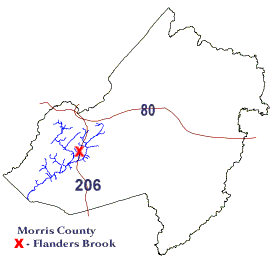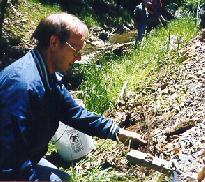| New Jersey Division of Fish, Game and Wildlife |

"They want to do WHAT?!!" was my initial reaction several years ago when I learned that the N.J. Department of Transportation was planning to widen a 4 mile stretch of Rt. 206 in Morris County. Their project would impact a small, yet incredibly productive, trout stream called Flanders Brook. This brook is one of only 4 streams statewide that are inhabited all by three stream dwelling trout species that reside in our state. The brook, brown, and rainbow trout living in Flanders Brook are not stocked...they're wild trout which means they  live and breed in the stream. Trout need clean, cold water, flowing over silt-free rocks and gravel in order to survive and spawn. In order for NJDOT to build a climbing lane the stream channel would have to be moved over, displacing the trout and destroying their habitat. Or would it?
live and breed in the stream. Trout need clean, cold water, flowing over silt-free rocks and gravel in order to survive and spawn. In order for NJDOT to build a climbing lane the stream channel would have to be moved over, displacing the trout and destroying their habitat. Or would it?
Before proceeding NJDOT had to obtain permits from other state agencies, particularly the Department of Environmental Protection. As part of that process their application had to pass through the Division of Fish, Game and Wildlife's Office of Environmental Review. As a direct result of our comments and concerns NJDOT was required to hire a consultant experienced in planning and performing stream channel relocations. The construction plan was to direct the stream flow into a pipe so that the new channel could be built under dry conditions. But before a single stone could be turned the fish had to be collected and moved to a more suitable location.
Just before excavation began, a crew composed of Division and DOT staff, and volunteers from the Division's Wildlife Conservation Corps arrived on the scene to relocate the fish. A battery-powered backpack electrofisher, which puts an electric field in the water to momentarily stun fish, enabled us to capture the trout. A 340-foot stretch yielded a total of 180 trout which were trucked to a more hospitable location downstream (the S/Br. Raritan River). The biggest trout was 10.3 inches, which is not bad for a stream that's only about 6 feet wide. Once this job was completed a new stream channel was constructed. This was accomplished in July, 1997, under the expert guidance of the consultant, Maryland-based Brightwater, Inc.
Would wild trout re-establish themselves in the new stream channel? Well, we were certain that that the wild trout living upstream and downstream of the disturbed site would eventually recolonize the new stream channel. We weren't sure just how long that would take. Should we speed up the process by stocking hatchery trout? Absolutely not! Stocking was not only unnecessary but potentially harmful. Interbreeding between wild and hatchery trout might result in offspring less adaptable to their environs. The hatchery trout would also compete for the best spots in the stream, forcing wild trout to occupy less favorable habitat. So it was deemed best to let nature take its course, with respect to the trout.
What about the stream banks, which were barren of vegetation following channel reconstruction? Should we let nature take its course here? Definitely not! Eroding stream banks are bad news for trout and the aquatic insects they feed upon.  Soil which is not held in place by the root structure of plants will wash into the stream covering the rocky bottom with a blanket of silt, suffocating insect life and trout eggs. To avoid this scenario the banks were seeded with grass to initially stabilize the bare ground. Then in early 1998 the WCC volunteers returned to the stream to plant dogwood seedlings.
Soil which is not held in place by the root structure of plants will wash into the stream covering the rocky bottom with a blanket of silt, suffocating insect life and trout eggs. To avoid this scenario the banks were seeded with grass to initially stabilize the bare ground. Then in early 1998 the WCC volunteers returned to the stream to plant dogwood seedlings.
These shrubs, and future plantings of willows, will help speed the recovery process. Shrubs and trees provide shade during the summer, preventing the sun from warming the water. They can also overhang into the stream, providing additional hiding cover for trout and habitat for terrestrial insects (more trout food). Their root structure helps stabilize the banks, further preventing erosion and siltation. Because this type of stream protection and enhancement is so important the Division is co-sponsoring a workshop in early November which will give landowners, fishing clubs, environmental commissions and watershed associations more information on how they can protect and enhance stream environments in their communities.
But those trout in Flanders Brook…how are they doing now, a year later? Quite nicely, I'm happy to report. A survey in August, 1998, revealed that all three trout species have taken up residence in the relocated channel. We did not encounter as many trout as before, but it may take a few years for the population to stabilize. Interestingly, there were more large trout than before, perhaps because the new channel contained larger pools preferred by big trout. Anglers who wish to try their luck in Flanders Brook should be aware that this stream is regulated as a wild trout stream. (Consult the Fish and Wildlife DIGEST for more complete regulation information.)
While it will take a number of years for the vegetation and fish population to become fully re-established, this stream environment is off to a good start thanks to our efforts and those of NJDOT, their contractors, and WCC volunteers.